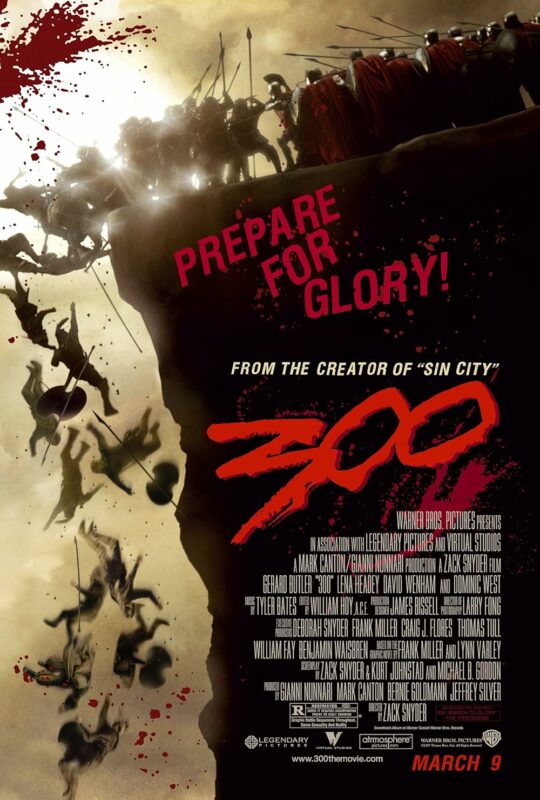How has this movie aged? Well, I crunched the numbers. 300 saw wide release on March 9th 2007, which means it has aged by 16 years, 8 months and 11 days.
In this comic book (technically a movie, but on a spiritual level it’s still a comic book), Spartans fight Asiatic hordes…err, Persians in a storm of limbic system carnage. The film is visceral in every sense of the world. Every sword-stroke is photogenically perfect. Blood sprays out with the artistry of Photoshop brush patterns. The dialog sounds like it was workshopped at a WWE writers’ meeting. 300 struggles so mightily to rouse the blood that you wish it succeeded.
300 is a macho fairytale. Nothing anyone says or does is a thing anyone would say or do under any set of circumstances, ever. There’s a weird logic to this: most historical accounts of the Battle of Thermopylae take an equally exaggerated tone. According to Herodotus, Xerxes brought 1,800,000 Persians to the battle (an army far beyond the supply trains of the ancient world), and they drank entire rivers dry as they marched. These are comic book details, and the movie plays the “history as a comic book” angle to the hilt. It’s all a story told by the fictional soldier Dilios on the eve of the battle of Platea: he’s transparently an unreliable narrator, a propagandist trying to raise the morale of the Greeks, and he knows not to let the truth get in the way of a good story.
“It’s fake, bro” is the movie’s get-out-of-jail card, played again and again. You cannot complain that any of the story’s details are unrealistic/illogical/offensive, because this is how Dilios is telling the story. It absolves Frank Miller and Zack Snyder of their excesses by putting those excesses in the mouth of a fictional narrator.
And they are excessive. The Persians have elephants bigger than the Oliphaunts in Return of the King. Xerxes stands exactly seventeen and a half feet tall (cut him in half and you could make two division-1 basketball players) and looks like a yassified Cenobite. At the start, Leonidas is shipped to the Spartan warrior school, or agōgē (“ah-go-gay”—the movie wimps out of pronouncing it that way, of course), where he learns to fight wolves while wearing a loincloth in the snow. The wolf looks like Gmork from The Neverending Story, and has “Claws of black steel…fur as dark night” (as opposed to those really bright nights where you go to bed wearing shades). This harsh training pays off, and the Spartan boys are forged into disciplined and resourceful warriors, capable of fighting tirelessly for weeks while eating (as far as I can recall) one apple between the lot of them. They also don’t seem to have any kit or gear, so I wonder what orifice they used to store the helmets they wear later on. I think I’ll skip the deleted scenes on the DVD.
I’m not sure if I like or even respect what 300 is doing.
First, this metafictional approach is kind of a cheat: the movie wants to eat its cake and also have it. It asks us to commit to a spectacle of blood and guts…only to pull back and say “lol, just a prank bro.” 300 is oddly guilty about what it is. The absurd Golden Age cheeseburger epics (which 300 aspires to be) were earnest and believed in the mission, but 300 is written with a certain defensiveness, as if trying to defend itself against criticisms. It’s like a sales pitch that starts off “Now, I know you’re thinking this is a scam…” Maybe I wasn’t, but I am now.
Also, if the events depicted on the screen are mostly lies, what do I get out of watching it? It hollows the whole experience for me. It’s not as if the film has anything interesting to say about the nature of history and propaganda. It wants us to take the blood-and-steroid crazed action seriously…only to yank the rug out from under as at the end. (Also, the movie undercuts its own framing device by depicting the “real” Battle of Platea in exactly the same gung-ho style as “fake” Thermopylae.)
We don’t even need Dilios as a framing device. The face-melting color grading, the omnipresent bloom and lens flares, the way bronze armor screams radioactively with light…this is the world exaggerated, transfixed by a fever-heat of fantasy until colors crack and run. You should not need to be told this is a fairy tale. Fantasy is stamped on every frame like a barcode.
In real life, Sparta was a slave state, where only about 15% of the population (the spartacoi) were considered citizens. But 300 trafficks in Sparta as symbols. It’s fitting for Dilios and Leonidas to prate anachronistic nonsense about Sparta being the world’s last hope for “reason and justice” (the Sparta that really existed made nearly no contributions to philosophy and governance). The movie does not depict Spartans, except in the loose textual sense that Hagar the Horrible depicts Vikings. Leonidas is not Leonidas. He’s He’s Davey Crockett. He’s Chris Kyle. He’s an American…or at least the American that Americans aspire to be. It’s like complaining that Batman doesn’t work the way police officers do in real life: he’s not supposed to.
The movie has all its defenses and escape clauses all lined up, ready to refute naysayers. Every criticism you can make is one Miller/Snyder (and Herodotus?) have anticipated, and already trimmed the claws off of. But that’s part of the problem. Heavy Metal doesn’t do that. I love style. But only when it’s paired with self-belief. Trying to hide behind a weaselly postmodern mask just doesn’t work. Ironically, 300 just lacks courage. An exuberant celebration of blood and thunder shouldn’t need to apologize so damned much.
No Comments »
Comments are moderated and may take up to 24 hours to appear.
No comments yet.

